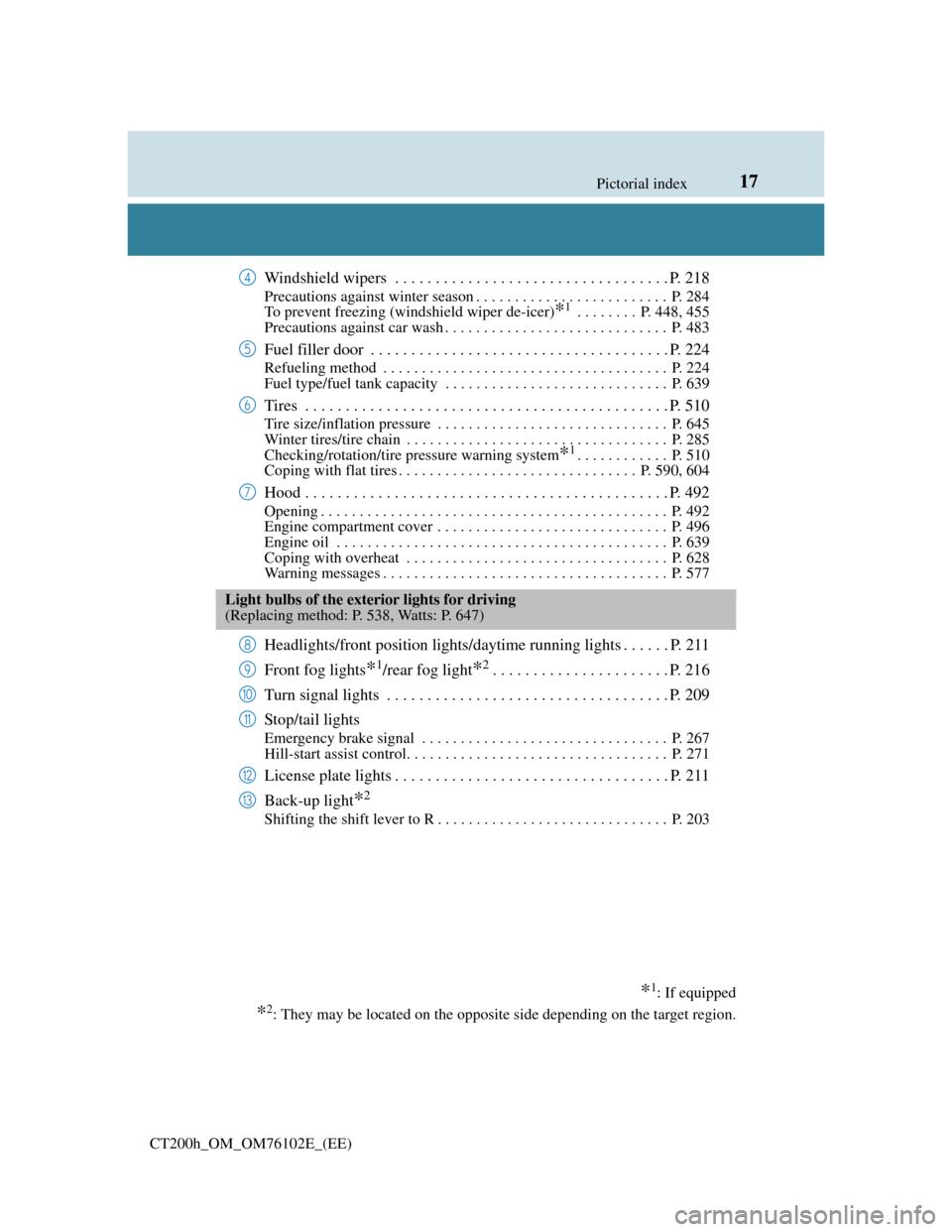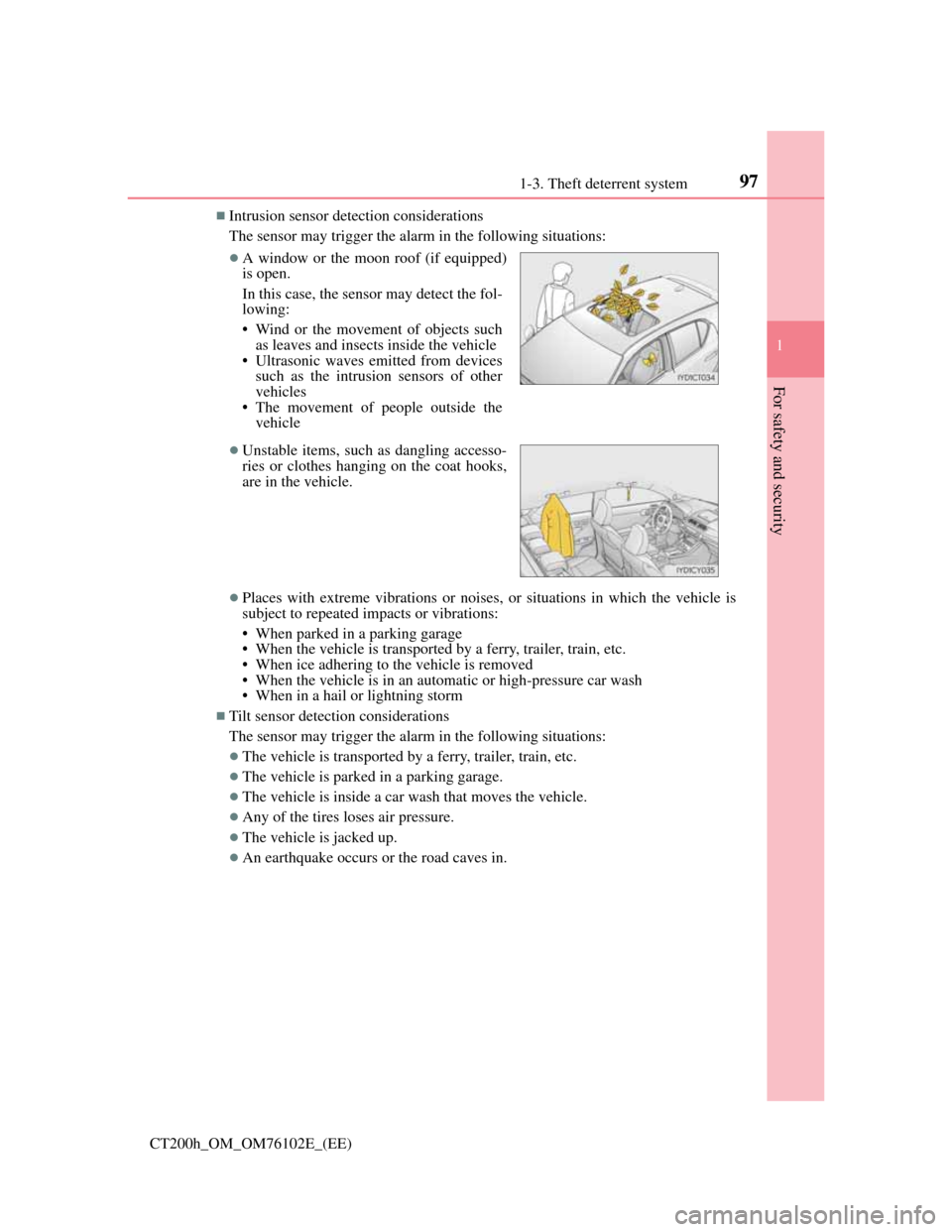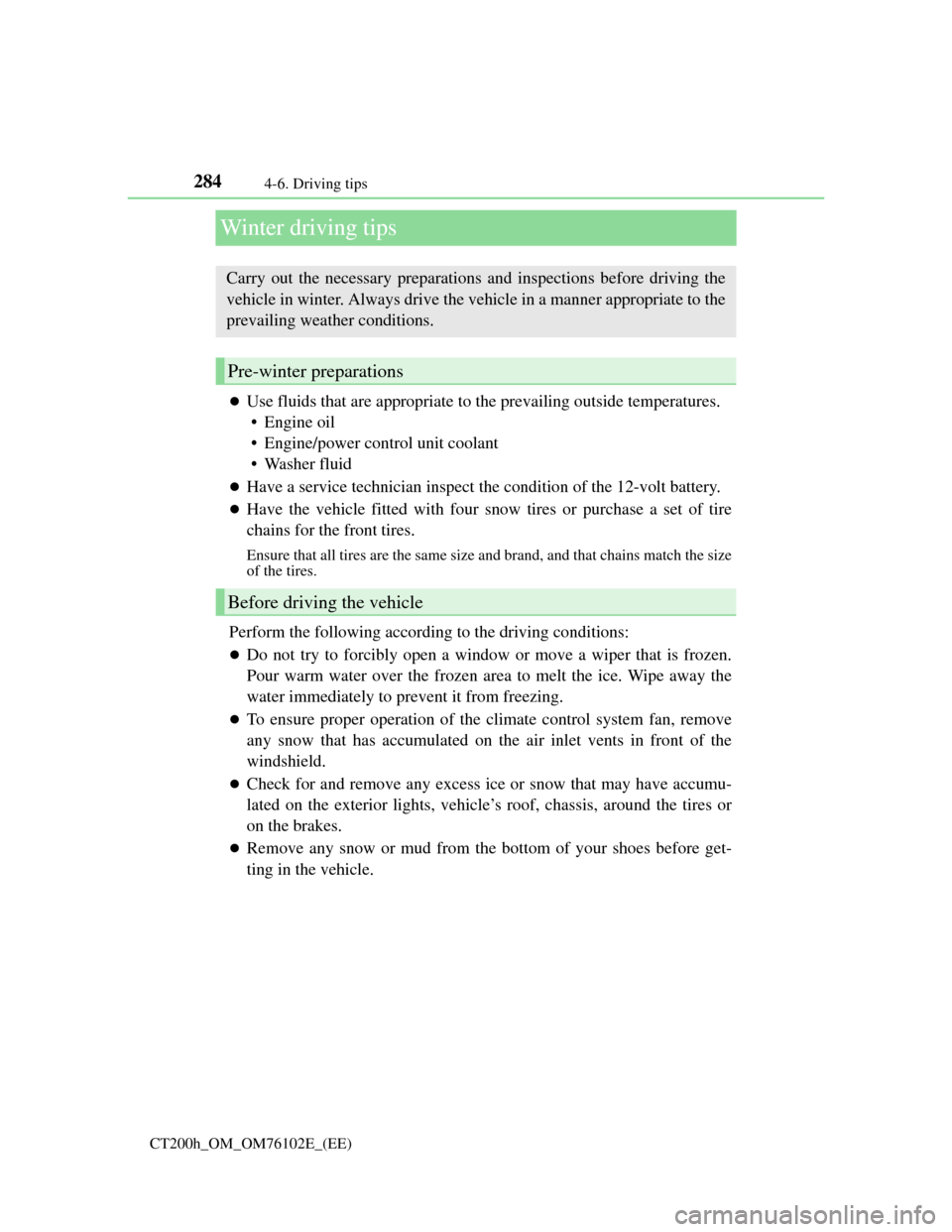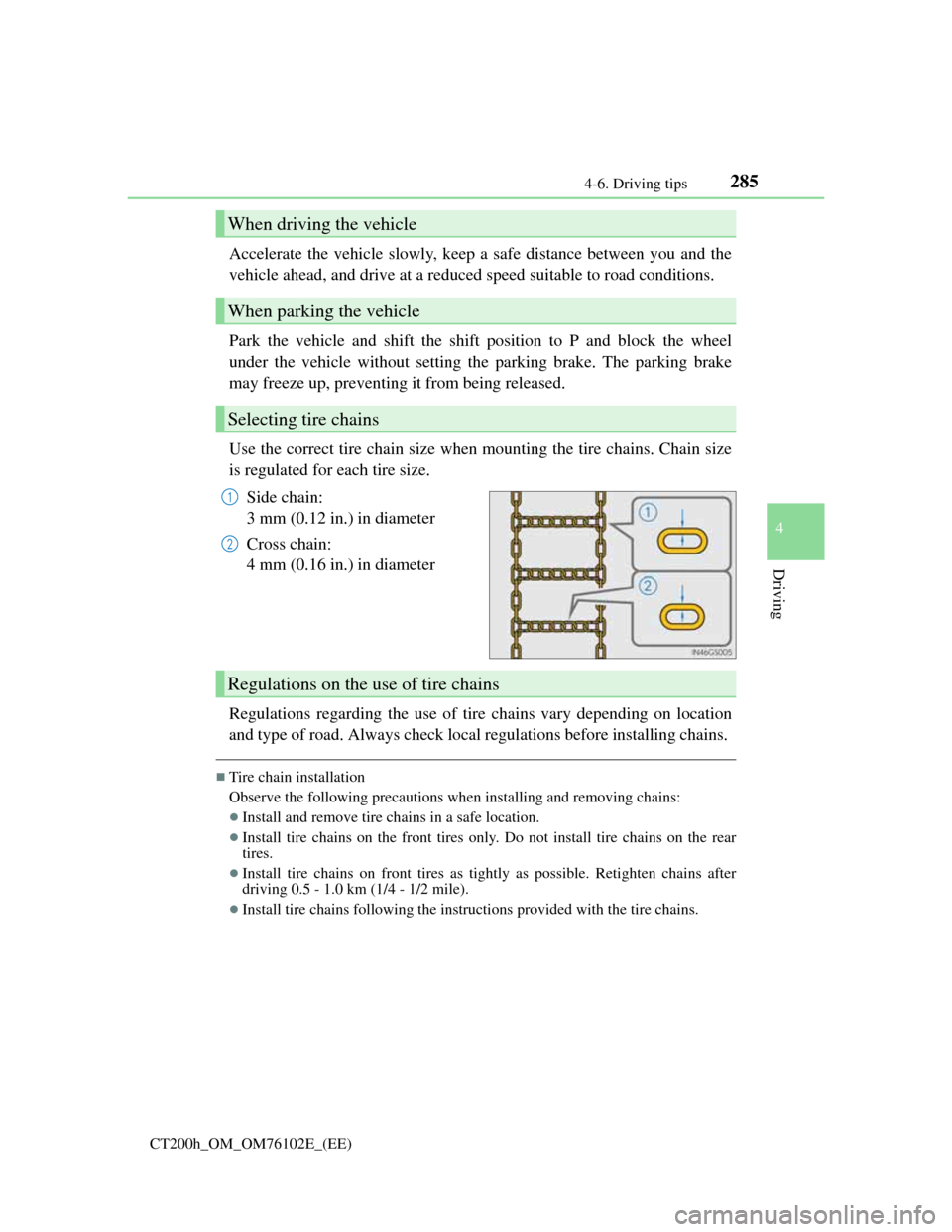tires Lexus CT200h 2013 Owner's Manual (in English)
[x] Cancel search | Manufacturer: LEXUS, Model Year: 2013, Model line: CT200h, Model: Lexus CT200h 2013Pages: 688
Page 7 of 688

7
1
8 7
6
5
4
3
2
CT200h_OM_OM76102E_(EE)
9
6-4. Other interior features
Other interior features ....... 473
• Sun visors...................... 473
• Vanity mirrors ............... 473
• Clock ............................. 474
• Power outlet .................. 475
• Assist grips.................... 477
7-1. Maintenance and care
Cleaning and protecting the
vehicle exterior.................480
Cleaning and protecting the
vehicle interior.................484
7-2. Maintenance
Maintenance require-
ments...............................4877-3. Do-it-yourself maintenance
Do-it-yourself service precau-
tions..................................490
Hood .................................. 492
Positioning a floor jack ..... 494
Engine compartment ......... 495
12-volt battery ................... 504
Tires................................... 510
Tire inflation pressure ....... 523
Wheels............................... 525
Air conditioning filter ....... 527
Electronic key battery ....... 530
Checking and replacing
fuses.................................534
Light bulbs ........................ 538
8-1. Essential information
Emergency flashers ........... 560
If your vehicle has to be stopped
in an emergency...............561
7Maintenance and care
8When trouble arises
Page 17 of 688

17Pictorial index
CT200h_OM_OM76102E_(EE)
Windshield wipers . . . . . . . . . . . . . . . . . . . . . . . . . . . . . . . . . . P. 218
Precautions against winter season . . . . . . . . . . . . . . . . . . . . . . . . . P. 284
To prevent freezing (windshield wiper de-icer)
*1 . . . . . . . . P. 448, 455
Precautions against car wash . . . . . . . . . . . . . . . . . . . . . . . . . . . . . P. 483
Fuel filler door . . . . . . . . . . . . . . . . . . . . . . . . . . . . . . . . . . . . . P. 224
Refueling method . . . . . . . . . . . . . . . . . . . . . . . . . . . . . . . . . . . . . P. 224
Fuel type/fuel tank capacity . . . . . . . . . . . . . . . . . . . . . . . . . . . . . P. 639
Tires . . . . . . . . . . . . . . . . . . . . . . . . . . . . . . . . . . . . . . . . . . . . . P. 510
Tire size/inflation pressure . . . . . . . . . . . . . . . . . . . . . . . . . . . . . . P. 645
Winter tires/tire chain . . . . . . . . . . . . . . . . . . . . . . . . . . . . . . . . . . P. 285
Checking/rotation/tire pressure warning system
*1. . . . . . . . . . . . P. 510
Coping with flat tires . . . . . . . . . . . . . . . . . . . . . . . . . . . . . . . P. 590, 604
Hood . . . . . . . . . . . . . . . . . . . . . . . . . . . . . . . . . . . . . . . . . . . . . P. 492
Opening . . . . . . . . . . . . . . . . . . . . . . . . . . . . . . . . . . . . . . . . . . . . . P. 492
Engine compartment cover . . . . . . . . . . . . . . . . . . . . . . . . . . . . . . P. 496
Engine oil . . . . . . . . . . . . . . . . . . . . . . . . . . . . . . . . . . . . . . . . . . . P. 639
Coping with overheat . . . . . . . . . . . . . . . . . . . . . . . . . . . . . . . . . . P. 628
Warning messages . . . . . . . . . . . . . . . . . . . . . . . . . . . . . . . . . . . . . P. 577
Headlights/front position lights/daytime running lights . . . . . . P. 211
Front fog lights
*1/rear fog light*2. . . . . . . . . . . . . . . . . . . . . . P. 216
Turn signal lights . . . . . . . . . . . . . . . . . . . . . . . . . . . . . . . . . . . P. 209
Stop/tail lights
Emergency brake signal . . . . . . . . . . . . . . . . . . . . . . . . . . . . . . . . P. 267
Hill-start assist control. . . . . . . . . . . . . . . . . . . . . . . . . . . . . . . . . . P. 271
License plate lights . . . . . . . . . . . . . . . . . . . . . . . . . . . . . . . . . . P. 211
Back-up light
*2
Shifting the shift lever to R . . . . . . . . . . . . . . . . . . . . . . . . . . . . . . P. 203
4
5
6
7
Light bulbs of the exterior lights for driving
(Replacing method: P. 538, Watts: P. 647)
*1: If equipped
*2: They may be located on the opposite side depending on the target region.
8
9
10
11
12
13
Page 97 of 688

971-3. Theft deterrent system
1
CT200h_OM_OM76102E_(EE)
For safety and security
Intrusion sensor detection considerations
The sensor may trigger the alarm in the following situations:
Places with extreme vibrations or noises, or situations in which the vehicle is
subject to repeated impacts or vibrations:
• When parked in a parking garage
• When the vehicle is transported by a ferry, trailer, train, etc.
• When ice adhering to the vehicle is removed
• When the vehicle is in an automatic or high-pressure car wash
• When in a hail or lightning storm
Tilt sensor detection considerations
The sensor may trigger the alarm in the following situations:
The vehicle is transported by a ferry, trailer, train, etc.
The vehicle is parked in a parking garage.
The vehicle is inside a car wash that moves the vehicle.
Any of the tires loses air pressure.
The vehicle is jacked up.
An earthquake occurs or the road caves in.
A window or the moon roof (if equipped)
is open.
In this case, the sensor may detect the fol-
lowing:
• Wind or the movement of objects such
as leaves and insects inside the vehicle
• Ultrasonic waves emitted from devices
such as the intrusion sensors of other
vehicles
• The movement of people outside the
vehicle
Unstable items, such as dangling accesso-
ries or clothes hanging on the coat hooks,
are in the vehicle.
Page 187 of 688

1874-1. Before driving
4
Driving
CT200h_OM_OM76102E_(EE)
Firmly set the parking brake with the brake pedal depressed, and then
shift the shift position to D.
Release the brake pedal and gently depress the accelerator pedal.
Release the parking brake.
When starting off on a uphill
The hill-start assist control is available. (P. 271)
For fuel-efficient driving
Keep in mind that hybrid vehicles are similar to conventional vehicles, and it is
necessary to refrain from activities such as sudden acceleration, etc. Refer to
“Hybrid vehicle driving tips”. (281)
Driving in the rain
Drive carefully when it is raining, because visibility will be reduced, the win-
dows may become fogged-up, and the road will be slippery.
Drive carefully when it starts to rain, because the road surface will be especially
slippery.
Refrain from high speeds when driving on an expressway in the rain, because
there may be a layer of water between the tires and the road surface, preventing
the steering and brakes from operating properly.
Breaking in your new Lexus
To extend the life of the vehicle, observing the following precautions is recom-
mended:
For the first 300 km (200 miles):
Avoid sudden stops.
For the first 2000 km (1200 miles):
• Do not drive at extremely high speeds.
• Avoid sudden acceleration.
• Do not drive at a constant speed for extended periods.
Operating your vehicle in a foreign country
Comply with the relevant vehicle registration laws and confirm the availability
of the correct fuel. (P. 639)
Starting off on a uphill
1
2
3
Page 265 of 688

265
4 4-5. Using the driving support systems
Driving
CT200h_OM_OM76102E_(EE)
WA R N I N G
When using the rear view monitor system
The rear view monitor system is a supplemental device intended to assist the
driver when backing up. When backing up, be sure to check visually behind
and all around the vehicle before proceeding.
Observe the following precautions to avoid an accident that could result in
death or serious injuries.
Never depend on the rear view monitor system entirely when backing up. The
image and the position of the guide lines displayed on the screen may differ
from the actual state.
Use caution, just as you would when backing up any vehicle.
Be sure to back up slowly, depressing the brake pedal to control vehicle
speed.
The instructions given are only guide lines.
When and how much to turn the steering wheel will vary according to traffic
conditions, road surface conditions, vehicle condition, etc. when parking. It is
necessary to be fully aware of this before using the rear view monitor system.
When parking, be sure to check that the parking space will accommodate your
vehicle before maneuvering into it.
Do not use the rear view monitor system in the following cases:
• On icy or slick road surfaces, or in snow
• When using tire chains or emergency tires
• When the back door is not closed completely
• On roads that are not flat or straight, such as curves or slopes.
In low temperatures, the screen may darken or the image may become faint.
The image could distort when the vehicle is moving, or you may become
unable to see the image on the screen. Be sure to check direct visually and
with the mirrors all around the vehicle before proceeding.
If the tire sizes are changed, the position of the fixed guide lines displayed on
the screen may change.
The camera uses a special lens. The distances between objects and pedestrians
that appear in the image displayed on the screen will differ from the actual
distances.
(P. 259)
Page 272 of 688

2724-5. Using the driving support systems
CT200h_OM_OM76102E_(EE)
WA R N I N G
The ABS does not operate effectively when
The limits of tire gripping performance have been exceeded (such as exces-
sively worn tires on a snow covered road).
The vehicle hydroplanes while driving at high speed on wet or slick road.
Stopping distance when the ABS is operating may exceed that of normal condi-
tions
The ABS is not designed to shorten the vehicle’s stopping distance. Always
maintain a safe distance from the vehicle in front of you, especially in the fol-
lowing situations:
When driving on dirt, gravel or snow-covered roads
When driving with tire chains
When driving over bumps in the road
When driving over roads with potholes or uneven surfaces
TRC may not operate effectively when
Directional control and power may not be achievable while driving on slippery
road surfaces, even if the TRC system is operating.
Drive the vehicle carefully in conditions where stability and power may be lost.
When the VSC is activated
The slip indicator light flashes. Always drive carefully. Reckless driving may
cause an accident. Exercise particular care when the indicator light flashes.
When the TRC system is turned off
Be especially careful and drive at a speed appropriate to the road conditions. As
these are the system to help ensure vehicle stability and driving force, do not
turn the TRC system off unless necessary.
Replacing tires
Make sure that all tires are of the specified size and of the same brand, tread
pattern and total load capacity. In addition, make sure that the tires are inflated
to the recommended tire inflation pressure level.
The ABS, VSC and TRC systems will not function correctly if different tires
are installed on the vehicle.
Contact any authorized Lexus dealer or repairer, or another duly qualified and
equipped professional for further information when replacing tires or wheels.
Handling of tires and the suspension
Using tires with any kind of problem or modifying the suspension will affect
the driving assist systems, and may cause a system to malfunction.
Page 284 of 688

2824-6. Driving tips
CT200h_OM_OM76102E_(EE)
Delays
Repeated acceleration and deceleration, as well as long waits at traffic
lights, will lead to bad fuel economy. Check traffic reports before leav-
ing and avoid delays as much as possible. When driving in a traffic
jam, gently release the brake pedal to allow the vehicle to move for-
ward slightly while avoiding overuse of the accelerator pedal. Doing so
can help control excessive gasoline consumption.
Highway driving
Control and maintain the vehicle at a constant speed. Before stopping
at a toll booth or similar, allow plenty of time to release the accelerator
and gently apply the brakes. A greater amount of electrical energy can
be regenerated when slowing down.
Air conditioning
Use the air conditioning only when necessary. Doing so can help
reduce excessive gasoline consumption.
In summer: When the ambient temperature is high, use the recirculated
air mode. Doing so will help to reduce the burden on the air condition-
ing system and reduce fuel consumption as well.
In winter: Because the gasoline engine will not automatically cut out
until it and the interior of the vehicle are warm, it will consume fuel.
Fuel consumption can be improved by avoiding overuse of the heater.
Checking tire inflation pressure
Make sure to check the tire inflation pressure frequently. Improper tire
inflation pressure can cause poor fuel economy.
Also, as snow tires can cause large amounts of friction, their use on dry
roads can lead to poor fuel economy. Use tires that are appropriate for
the season.
Page 286 of 688

2844-6. Driving tips
CT200h_OM_OM76102E_(EE)
Winter driving tips
Use fluids that are appropriate to the prevailing outside temperatures.
•Engine oil
• Engine/power control unit coolant
•Washer fluid
Have a service technician inspect the condition of the 12-volt battery.
Have the vehicle fitted with four snow tires or purchase a set of tire
chains for the front tires.
Ensure that all tires are the same size and brand, and that chains match the size
of the tires.
Perform the following according to the driving conditions:
Do not try to forcibly open a window or move a wiper that is frozen.
Pour warm water over the frozen area to melt the ice. Wipe away the
water immediately to prevent it from freezing.
To ensure proper operation of the climate control system fan, remove
any snow that has accumulated on the air inlet vents in front of the
windshield.
Check for and remove any excess ice or snow that may have accumu-
lated on the exterior lights, vehicle’s roof, chassis, around the tires or
on the brakes.
Remove any snow or mud from the bottom of your shoes before get-
ting in the vehicle.
Carry out the necessary preparations and inspections before driving the
vehicle in winter. Always drive the vehicle in a manner appropriate to the
prevailing weather conditions.
Pre-winter preparations
Before driving the vehicle
Page 287 of 688

2854-6. Driving tips
4
Driving
CT200h_OM_OM76102E_(EE)
Accelerate the vehicle slowly, keep a safe distance between you and the
vehicle ahead, and drive at a reduced speed suitable to road conditions.
Park the vehicle and shift the shift position to P and block the wheel
under the vehicle without setting the parking brake. The parking brake
may freeze up, preventing it from being released.
Use the correct tire chain size when mounting the tire chains. Chain size
is regulated for each tire size.
Side chain:
3 mm (0.12 in.) in diameter
Cross chain:
4 mm (0.16 in.) in diameter
Regulations regarding the use of tire chains vary depending on location
and type of road. Always check local regulations before installing chains.
Tire chain installation
Observe the following precautions when installing and removing chains:
Install and remove tire chains in a safe location.
Install tire chains on the front tires only. Do not install tire chains on the rear
tires.
Install tire chains on front tires as tightly as possible. Retighten chains after
driving 0.5 - 1.0 km (1/4 - 1/2 mile).
Install tire chains following the instructions provided with the tire chains.
When driving the vehicle
When parking the vehicle
Selecting tire chains
1
2
Regulations on the use of tire chains
Page 288 of 688

2864-6. Driving tips
CT200h_OM_OM76102E_(EE)
WA R N I N G
Driving with snow tires
Observe the following precautions to reduce the risk of accidents.
Failure to do so may result in a loss of vehicle control and cause death or seri-
ous injury.
Use tires of the specified size.
Maintain the recommended level of air pressure.
Do not drive at speeds in excess of the speed limit or the speed limit specified
for the snow tires being used.
Use snow tires on all, not just some wheels.
Driving with tire chains
Observe the following precautions to reduce the risk of accidents.
Failure to do so may result in the vehicle being unable to be driven safely, and
may cause death or serious injury.
Do not drive in excess of the speed limit specified for the tire chains being
used, or 50 km/h (30 mph), whichever is lower.
Avoid driving on bumpy road surfaces or over potholes.
Avoid sudden acceleration, abrupt steering, sudden braking and shifting oper-
ations that cause sudden engine braking.
Slow down sufficiently before entering a curve to ensure that vehicle control
is maintained.
When parking the vehicle
When parking the vehicle without applying the parking brake, make sure to
chock the wheels. If you do not chock the wheels, the vehicle may move unex-
pectedly, possibly resulting in an accident.
NOTICE
Repairing or replacing snow tires (vehicles with the tire pressure warning sys-
tem)
Request repairs or replacement of snow tires from any authorized Lexus dealer
or repairer, or another duly qualified and equipped professional or legitimate
tire retailers.
This is because the removal and attachment of snow tires affects the operation
of the tire pressure warning valves and transmitters.
Fitting tire chains (vehicles with the tire pressure warning system)
The tire pressure warning valves and transmitters may not function correctly
when tire chains are fitted.